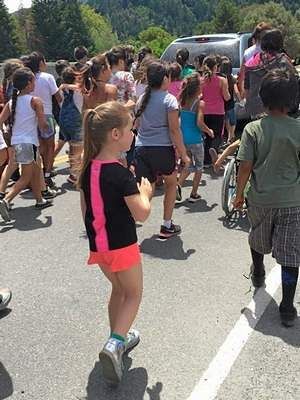 |
Canku Ota
|
 |
|
(Many Paths)
|
||
|
An Online Newsletter
Celebrating Native America
|
||
|
June 2015 - Volume 13
Number 6
|
||
|
|
||
|
Hoopa Community Runs
With The Salmon
|
||
|
by Tabitha Soden - Eureka
Times-Standard
|
||
Hundreds of Hoopa youth and community members ran two-mile sprints along the Klamath River on Friday to represent the spring salmon migration and to raise awareness about the struggles faced by the fish. The run has been hosted along the river for the past 13 years and was started by students from Hoopa Valley High School in response to the death of an estimated 68,000 Chinook salmon caused by low water levels in 2002, according to a Hoopa Valley Tribal Fisheries press release. Participants carry a salmon-shaped baton and run two-mile segments of the Klamath River — from the Pacific Ocean to the South Fork of the Trinity River — before passing the baton to the next runner. This symbolizes the migration of the salmon and helps educate youth on the plight of the salmon, according to the release. "The salmon's struggles are our struggles. For that short time we take on their struggles," said Erica Chase, an event co-founder and Hoopa Valley tribal member. While many conservation efforts focus on the science and politics of protecting the salmon, the yearly run also incorporates the spiritual importance of the salmon to the Hupa people. Following the run, a long-held Hoopa tradition called the First Salmon Ceremony is conducted. During the ceremony, a salmon is cooked and eaten by designated people who then commit to not eat salmon for a year. This abstinence is a part of the medicine to insure the continuance of the salmon, according to Viv Orcutt, a Hoopa Valley tribal member. Orcutt said the salmon, and their spring migration, are an important part of the tribe's culture and creation story. "The creator made these salmon fattier because he knew we were just coming out of the lean months, the winter months. He did it that way to take care of the animals and the people," Orcutt said. But salmon have faced many troubles in past years. In addition to the adult fish kill in 2002, juvenile salmon have been recently dying as a result of a parasite called Ceratomyxa shasta. All of the juvenile salmon tested in the Shasta to Scott reach of the Klamath River tested positive for the parasite as of April 30. As of May 4, all the salmon tested from the Scott to Salmon reach of the river were also infected, according to fish monitoring data from the US Fish and Wildlife's California-Nevada Fish Health Center. And the chances of juvenile salmon dying along other areas of the Klamath is becoming more likely as research finds increased numbers of the parasite between the Iron Gate Dam in Siskiyou County and the Weitchpec River, according to the Klamath Basin Monitoring Program. Orcutt said the run is a way to educate the youth of the community. Children of the community have also been learning about the salmon in other ways, by taking field trips to see their migration patterns. "Elders in the community have been joining the kids and talking to them about passing along the responsibility and about why we need to fight," Orcutt said. Tribal members have been fighting for the salmon in other ways. In 2000, the tribe helped secure long-term water supplies in the Trinity River with the adoption of the Trinity River Record of Decision, which redirected 250,000 acre feet of water from the Central Valley back to the river, according to the release. The tribe has also led efforts to secure additional water in the lower Klamath to avoid another fish kill, something that has been contested in federal court by Central Valley farmers. The annual run is just one of the many ways the Hoopa Valley Tribe is working to protect the salmon and its way of life, and is a way to teach that responsibility to the youth of the community. "We genuinely care about this, and about our children's future," Orcutt said. |
|||||
|
|
||
|
|
||
| Canku Ota is a free Newsletter celebrating Native America, its traditions and accomplishments . We do not provide subscriber or visitor names to anyone. Some articles presented in Canku Ota may contain copyright material. We have received appropriate permissions for republishing any articles. Material appearing here is distributed without profit or monetary gain to those who have expressed an interest. This is in accordance with Title 17 U.S.C. Section 107. | ||
|
Canku Ota is a copyright ©
2000 - 2015 of Vicki Williams Barry and Paul Barry.
|
||
 |
 |
|
|
The "Canku
Ota - A Newsletter Celebrating Native America" web site and
its design is the
|
||
|
Copyright ©
1999 - 2015 of Paul C. Barry.
|
||
|
All Rights Reserved.
|
||

